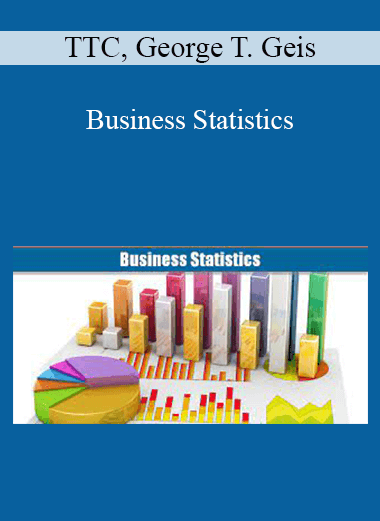TTC, George T. Geis – Business Statistics
TTC, George T. Geis – Business Statistics
Digital Download: You will receive a download link via your order email
In our tightly wired world, business executives make decisions under pressure. Almost always, these decisions must be made with less than complete information. This course is about how to effectively use data that is currently available (or can be obtained within a reasonable time frame and cost) to improve business decision-making.
Original price was: $35.00.$15.00Current price is: $15.00.
57% Off


Secure Payments
Pay with the worlds payment methods.

Discount Available
Covers payment and purchase gifts.

100% Money-Back Guarantee

Need Help?
(484) 414-5835
Share Our Wines With Your Friends & Family
Description
Business Statistics
Business executives make decisions under pressure. The decisions must be made with less than complete information.
This course will teach you how to use data that is currently available and can be obtained within a reasonable time frame.
Quantitative methods do not eliminate the vital role that seasoned business intuition plays. Many decisions are made using analytical techniques.
Statistics are relevant in the context of life and business. Business examples from functional areas such as finance, marketing, human resources, and operations are used to demonstrate the role of data analysis in decision-making by Professor George T. Geis of the UCLA Business School.
He says the course isn’t designed to be a dry, sleepy-time set of abstract, mathematical lectures. In the context of life and real business problems, the goal is to make statistics come alive.
The burden of computation has been eliminated through personal computers. Business people can now focus on probing issues and looking for creative solutions. The course shows how computer-generated output can be used to promote visualization of data.
In this course, we show how statistics and probability can work together with managerial intuition to solve business problems.
Statistics were hard for students to understand as undergraduates. They get ready for the worst on the first day of class in my Statistics and Data Analysis course. I am able to help them build intuition for statistics, appreciate how the content can be applied, and enjoy the experience.
Our main goal is to make the content useful to you in business decision-making and relevant to decisions we all make in everyday life.
You have an overview of probability and statistics. A business leader can have a significant competitive advantage by obtaining and analyzing data.
We need to make decisions based on the data we have. Statistics can be used to develop a model for refining business decisions.
There are 16 Lectures.
Professor compares statistics with probability in the first lecture. He shows the major activities of statistical analysis.
The purpose of descriptive statistics is discussed in the second lecture. How can we view and summarize data? In analyzing a business situation, why is variability so important?
The third lecture explores probability concepts. In refining intuition, probability plays an important role. In business situations, complexity is often the norm. In order for a model to be adequate, it must have room for complexity.
The fourth lecture combines event probabilities. We talk about how to get probabilities for complex events. Simulation is introduced, how it relates to probability, and how it can be used in business decision-making. The intuition behind conditional probability, independence, and mutual exclusivity is developed by us.
Simulation builds on our understanding of probability. The steps in setting up a Monte Carlo simulation are reviewed. To build a good simulation model, you need to understand how probabilities and distributions work.
In lecture 6 we discuss the idea of a random variable. We differentiate between random variables and distributions. Business problem-solving and simulation are related to distributions. It is possible to calculate business solutions and to model business problems.
The lecture talks about the use of distributions. Two useful distributions are given special attention. Business situations that involve percentage estimates involve the binomial distribution. The number of times an event is likely to happen depends on the average rate of occurrence.
The normal distribution plays a special role in statistics and probability. In this lecture, we look at the normal distribution. The standardized normal distribution is used in business.
Questions about sampling are answered in lecture 9. Random sampling is used in business analysis and decision-making. Why is a sampling distribution important? How do you pick out a random sample? Statistics address the issue of whether or not a sample is representative of the population.
The central limit theorem is looked at in lecture 10. One of the most important results in statistics is provided by this theorem. How useful is the central limit theorem in business analysis? How can we use sampling distributions for statistics such as the sample mean and sample proportion?
In lecture 11 we explain how confidence intervals are used in a business context. In business, we often need to estimate the characteristics of a population based on information provided by a sample chosen and analyzed to give us a good enough estimate. This estimate is translated into a mathematical statement of the level of confidence.
In lecture 12 we discuss confidence intervals. We show how to make confidence intervals for parameters other than the mean. If confidence intervals are useful, we consider what is necessary.
The use of hypothesis testing in business is explored in the 13th lecture. Our data is limited to a sample of reality. It is possible to test how large a part chance is in the results. The purpose of the hypothesis test is to determine whether or not a claim should be allowed to stand.
Linear regression is a method for modeling the relationship between two variables. Training and job performance are examples. Regression is a widely used technique that provides a useful mathematical representation of a real-world situation.
Even though we run a regression, it doesn’t guarantee that it is useful or valid. For a small range of values, a regression may be valid. In this lecture, we show you how to determine if the regression equation is valid for business analysis. The goal of regression is not just to fit a line to a set of data points but to be able to use it to forecast and predict.
An introduction to multiple regression is provided in lecture 16. Multiple regression is an extension of linear regression that uses more than one independent variable to explain variation in the dependent variable. We look at the use of dummy variables in regression models. More effective decision-making is often the result of combining analytical and statistical modeling with business experience and intuition.
Is it a good idea to buy audio or video?
More than 200 computer-generated graphics illustrating lecture overviews, term definitions, statistical data sets and models, statistical processes, hypothetical examples, and graphs are included in this course. Professor Geis uses a chalkboard and a whiteboard to further illustrate statistical data sets, hypothetical examples, statistical processes and equations, charts, and graphs.
At nextskillup.com, you can get TTC, George T. Geis.
Delivery Method
– After your purchase, you’ll see a View your orders link which goes to the Downloads page. Here, you can download all the files associated with your order.
– Downloads are available once your payment is confirmed, we’ll also send you a download notification email separate from any transaction notification emails you receive from nextskillup.com.
– Since it is a digital copy, our suggestion is to download and save it to your hard drive. In case the link is broken for any reason, please contact us and we will resend the new download link.
– If you cannot find the download link, please don’t worry about that. We will update and notify you as soon as possible at 8:00 AM – 8:00 PM (UTC 8).
Thank You For Shopping With Us!
OUR BEST COLLECTION OF COURSES AND BOOKS





Reviews
There are no reviews yet.